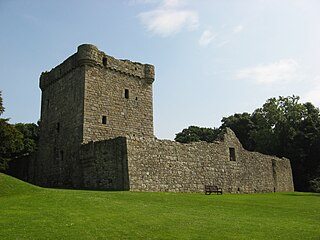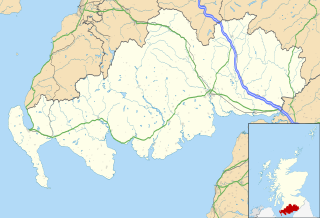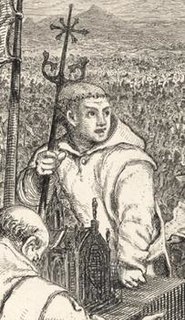| |||||
| Centuries: | |||||
|---|---|---|---|---|---|
| Decades: | |||||
| See also: | List of years in Scotland Timeline of Scottish history 1318 in: England • Elsewhere | ||||
Events from the year 1318 in the Kingdom of Scotland .
| |||||
| Centuries: | |||||
|---|---|---|---|---|---|
| Decades: | |||||
| See also: | List of years in Scotland Timeline of Scottish history 1318 in: England • Elsewhere | ||||
Events from the year 1318 in the Kingdom of Scotland .

Robert I, popularly known as Robert the Bruce, was King of Scots from 1306 to his death in 1329. Robert was one of the most famous warriors of his generation and eventually led the Kingdom of Scotland during the First War of Scottish Independence against England. He fought successfully during his reign to regain Scotland's place as an independent country and is now revered in Scotland as a national hero.

The Wars of Scottish Independence were a series of military campaigns fought between the Kingdom of Scotland and the Kingdom of England in the late 13th and early 14th centuries.

Robert II was King of Scots from 1371 to his death in 1390. He was the first monarch of the House of Stewart as the son of Walter Stewart, 6th High Steward of Scotland, and of Marjorie Bruce, daughter of the Scottish king Robert the Bruce by his first wife Isabella of Mar.

Earl of Elgin is a title in the Peerage of Scotland, created in 1633 for Thomas Bruce, 3rd Lord Kinloss. He was later created Baron Bruce, of Whorlton in the County of York, in the Peerage of England on 30 July 1641. The Earl of Elgin is the hereditary Clan Chief of Clan Bruce.

Lochleven Castle is a ruined castle on an island in Loch Leven, in the Perth and Kinross local authority area of Scotland. Possibly built around 1300, the castle was the site of military action during the Wars of Scottish Independence (1296–1357). In the latter part of the 14th century, the castle was granted to William Douglas, 1st Earl of Douglas, by his uncle. It remained in the Douglases' hands for the next 300 years. Mary, Queen of Scots, was imprisoned there in 1567–68, and forced to abdicate as queen, before escaping with the help of her gaoler's family. In 1588, the queen's gaoler inherited the title of Earl of Morton, and moved away from the castle. In 1675, Sir William Bruce, an architect, bought the castle and used it as a focal point for his garden; it was never again used as a residence.

Sir James Douglas was a Scottish knight and feudal lord. He was one of the chief commanders during the Wars of Scottish Independence.

St Mary's Abbey, Melrose is a partly ruined monastery of the Cistercian order in Melrose, Roxburghshire, in the Scottish Borders. It was founded in 1136 by Cistercian monks at the request of King David I of Scotland and was the chief house of that order in the country until the Reformation. It was headed by the abbot or commendator of Melrose. Today the abbey is maintained by Historic Environment Scotland as a scheduled monument.
Thomas Randolph, Earl of Moray was a soldier and diplomat in the Wars of Scottish Independence, who later served as regent of Scotland. He was a nephew of Robert the Bruce, who created him as the first earl of Moray. He was known for successfully capturing Edinburgh Castle from the English, and he was one of the signatories of the Declaration of Arbroath.

The First War of Scottish Independence was the first of a series of wars between English and Scottish forces. It lasted from the English invasion of Scotland in 1296 until the de jure restoration of Scottish independence with the Treaty of Edinburgh–Northampton in 1328. De facto independence was established in 1314 at the Battle of Bannockburn. The wars were caused by English kings attempting to establish their authority over Scotland while Scots fought to keep English rule and authority out of Scotland.

Annan is a town and former royal burgh in Dumfries and Galloway, south-west Scotland. Historically part of Dumfriesshire, its public buildings include Annan Academy, of which the writer Thomas Carlyle was a pupil, and a Georgian building now known as "Bridge House". The Town Hall was built in Victorian style in 1878, using the local sandstone. Annan also features a Historic Resources Centre. In Port Street, some of the windows remain blocked up to avoid paying the window tax.
Walter Stewart was the 6th Hereditary High Steward of Scotland and was the father of King Robert II of Scotland, the first Stewart monarch.

Lochmaben is a small town and civil parish in Scotland, and site of a castle. It lies 4 miles (6 km) west of Lockerbie, in Dumfries and Galloway.

Robert V de Brus, 5th Lord of Annandale, was a feudal lord, justice and constable of Scotland and England, a regent of Scotland, and a competitor for the Scottish throne in 1290/92 in the Great Cause. His grandson Robert the Bruce eventually became King of Scots.

William de Lamberton, sometimes modernized as William Lamberton, was Bishop of St Andrews from 1297 until his death. Lamberton is renowned for his influential role during the Scottish Wars of Independence. He campaigned for the national cause under William Wallace and later Robert the Bruce. As Bishop of St Andrews, the most powerful seat in Scotland, Bishop Lamberton along with Bishop Robert Wishart of Glasgow conducted the coronation of Robert the Bruce as King Robert I. Lamberton would go on to have a vital role in the formulation of the Declaration of the Clergy 1310 and the Declaration of Arbroath which would lead to Scottish Independence.
Sir Archibald Douglas was a Scottish nobleman, Guardian of Scotland, and military leader. He is sometimes given the epithet "Tyneman", but this may be a reference to his great-nephew Archibald Douglas, 4th Earl of Douglas.

Lauderdale is a long narrow geographical district in the Scottish Borders, Scotland, being the valley of the Leader Water,, above which rivulet St. Cuthbert had a vision of St. Aidan's soul being conducted to heaven. It is traversed from end to end by the A68 trunk road which runs from Darlington to Edinburgh.

The siege of Berwick was an event in the First War of Scottish Independence which took place in April 1318. Sir James Douglas, Lord of Douglas took the town and castle of Berwick-upon-Tweed from the English, who had controlled the town since 1296.

Outlaw King, stylized as Outlaw/King, is a 2018 historical action drama film about Robert the Bruce, the 14th-century Scottish King who launched a guerilla war against the larger English army. The film largely takes place during the 3-year historical period from 1304, when Bruce decides to rebel against the rule of Edward I over Scotland, thus becoming an "outlaw", up to the 1307 Battle of Loudoun Hill. Outlaw King was co-written, produced, and directed by David Mackenzie. It stars Chris Pine, Aaron Taylor-Johnson, Florence Pugh, Billy Howle, Sam Spruell, Tony Curran, Callan Mulvey, James Cosmo, and Stephen Dillane.

The siege of Berwick lasted four months in 1333 and resulted in the Scottish-held town of Berwick-upon-Tweed being captured by an English army commanded by King Edward III. The year before, Edward Balliol had seized the Scottish Crown, surreptitiously supported by Edward III. He was shortly expelled from the kingdom by a popular uprising. Edward III used this as a casus belli and invaded Scotland. The immediate target was the strategically important border town of Berwick.

George Douglas of Parkhead,, was a Scottish landowner, mining entrepreneur, Provost of Edinburgh, and Keeper of Edinburgh Castle.